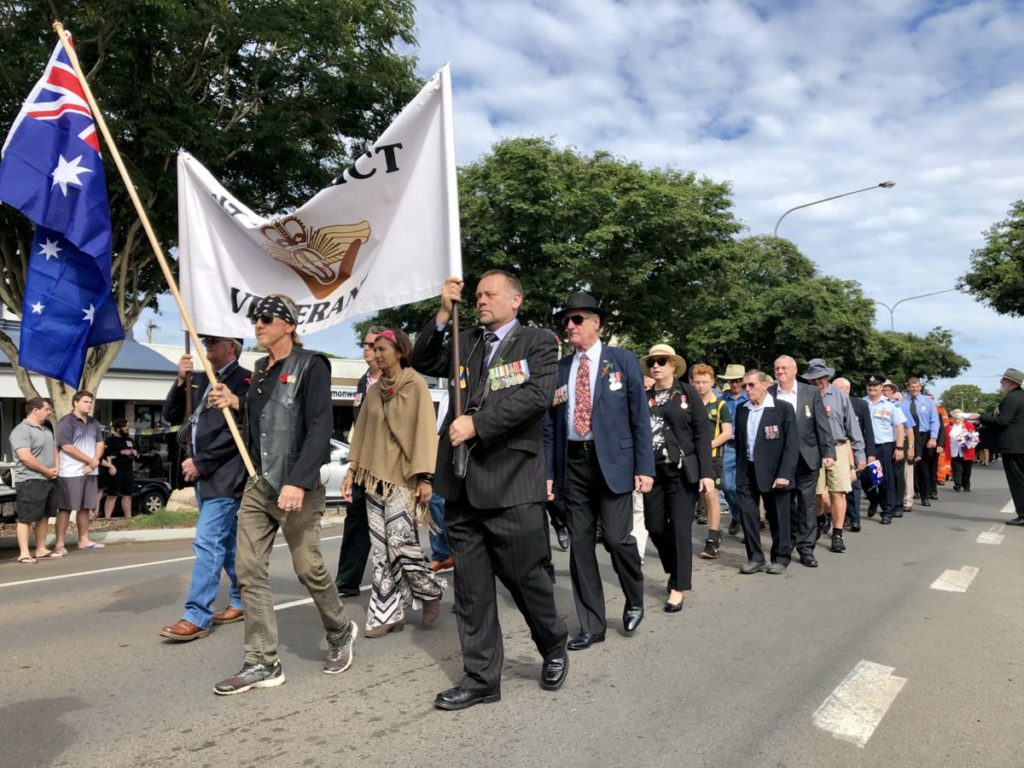Woodgate resident Steve Johnston gave the Anzac Day address at his home ceremony. Today we publish his reflections including those of his grandfather and the former Isis Shire men and women who served. The video was produced by Steve’s daughter Claire Johnston.
By Steve Johnston
This Anzac day we commemorate the 100th anniversary of the first Anzac Day ever held in peacetime.
One hundred years ago, on the 25th April 1919, Australians and New Zealanders gathered and held ceremonies for Anzac Day after the end of the Great War, which had finished with the signing of the Armistice some five and half months earlier.
Anzac Day marks the landing at Gallipoli by the Australian Imperial Force in 1915, where, in the ensuing eight months of battle they would lose over 8000 men and suffer 26,000 casualties.
Nine hundred men died in that last week of April 1915 alone, as the Australian forces landed ill-prepared and oblivious to what lay in wait for them.
The evacuation of Gallipoli in December of that year is often viewed as a strategic military triumph — in that no Australian soldier lost their life during that retreat — but we should never lose sight of the fact that almost 1000 soldiers a month died there in that bleak, harsh and unfamiliar terrain.
Gallipoli was of course a prelude for the three years of hell that lay ahead for the AIF particularly for those that fought on the Western Front.
At the end of that terrible war, of the 330,000 Australian soldiers who enlisted, 60,000 had died while serving their country. Another 155,000 soldiers were wounded including being gassed, suffering from shellshock (as it was then known) or incurring debilitating physical injuries such as limb amputation or loss of sight or hearing.
Many of those surviving soldiers were not back in their own country for that Anzac Day in 1919 as they were gradually transported back from Britain during the first eight months of the year after the war.
So for those Gallipoli veterans who had also survived the carnage on the western front in France and Belgium or in Palestine, many didn’t see their homeland for over four years. They were to miss Christmases, birthdays, marriages, births and funerals and all other family milestones during that time.
What had begun in 1914 with spirited patriotism and the promise of an overseas adventure by the end of the war had turned into a gruelling and bloody nightmare.
Grandfather served at Gallipoli
My own grandfather, Ben Johnston, whose medals I proudly wear today, was an Anzac serving at Gallipoli, in the Sinai and on the western front. On Anzac Day 100 years ago today he was on a troop ship returning from England where they had been stationed since January that year. Ben didn’t see Australia or his family for four years and 13 days.
During the 1920s, Anzac Day became established as a national day of commemoration and in 1927, for the first time, every state observed some form of public holiday on Anzac Day.
By the mid-1930s all the rituals we now associate with the day such as dawn services, marches, memorial services and two-up games were firmly established as part of Anzac Day culture in Australia and New Zealand.
During the 1920s there many memorials erected in all parts of Australia and New Zealand to honour the fallen and those that served; Cenotaphs, parks, avenues of trees, arches, swimming pools and halls were erected as memorials to those soldiers that served in WW1.
In many of those once thriving bustling agricultural towns it is doubtful if you would find as many young men of a soldiering age today, as the number you see recognised on those memorials as having given their lives or having served in that war.
Those memorials dot the cities, towns and villages with usually a marble or stone obelisk or cross, with a soldier resting at arms atop them sometimes in a main street but often in a quiet park. The services we have today are often commemorated at those sites.
Apart from Anzac day or Remembrance Day they are seldom looked at or visited at other times of the year but they remain powerful and poignant reminders of the sacrifices those young men made when they left their towns and communities to serve their country in a war on another continent.
Those memorials were very important to those communities and families after WW1 for another reason; only two soldier’s bodies were ever repatriated to Australia from that war.
They were General William Bridges who died after being shot by a sniper in Monash Valley at Gallipoli, who had been the first commander at Duntroon Military College in Canberra and the Unknown Soldier whose remains from Villers-Bretonneux were re-interred in the Australian War Memorial some 75 years later in 1993.

Ironically, but fittingly those two soldiers’ tombs now sit less than two kilometres apart in Canberra. But those tombs also reflect the fact that where they died were the two spheres of conflict in WW1 where we incurred the heaviest losses.
23,000 Australian soldiers who died in WW1 have no known grave, exacerbated by the fact that the war happened on the other side of the world in places few Australians at that time would ever get the opportunity to visit; those families who were grieving the loss of family members needed somewhere to reflect and honour their memories at home, in their communities.
Many of those memorials were created by their families or friends in those communities by fund raising locally; In Childers the unique soldiers memorial hall adjacent to the Isis Shire council building which honours those soldiers whose lives were lost, was realized largely because of the efforts of the then shire clerk, Herbert Epps whose son James Epps was killed on the Somme in 1917, less than three months after having been stationed in France.
The memorials in our capital cities are on a much grander scale but still represent the same sentiments. If you have been fortunate enough to visit the Australian War memorial in Canberra one of the most striking aspects of that magnificent building is its siting; it looks down Anzac Parade in perfect symmetrical alignment with both old and new Parliament houses.
This to me, reflects the significance of the contribution of the Australian armed forces in all wars — that is they helped to preserve the freedoms we have and the democratic system of government we still enjoy today.
“Today most people I know are repulsed by war, but war is often only a small part of the battle that determines the rest of a soldier’s life,” (Well Done Those Men, Barry Heard).
Those words weren’t written by a veteran of WW1 or for that matter WW2, they were written by a national servicemen who served in Vietnam in 1967 but was still coming to terms with the aftermath of that experience 30 years later whilst suffering from what we now know as Post traumatic stress syndrome.
Following World War One however, thousands of returned men carried their physical injuries or mental scars which they endured for the rest of their lives. Trench warfare in particular, had traumatized many men forever.
Before World War 2 started, over 40,000 First World War returned soldiers had died. That represents 15 per cent of all the surviving WW1 soldiers.
Some took their own life as they struggled to re-adjust to civilian life or to come to terms with their experiences; sadly one high profile case was Major General Pompey Elliot who had been a distinguished, highly decorated soldier and much admired leader during the war, who could not overcome his depression after the war.
Many families who had longed for the safe return of their men were then faced with years of care, nursing or support for those who came back but were changed physically and mentally forever.
Soldier settlement programs for many men and their families were miserable failures adding to their woes… and the resilience of these men was to be further tested with the Great Depression which started less than 10 years after their return.
In the 1920s nearly 100,000 ex-servicemen were receiving a war disability pension. Australia’s economy, already decimated by the cost of the war and the loss of productivity, was further impacted by this huge cost.
My Grandfather Ben was one of the fortunate ones; whilst enduring wounds he incurred in the war for the rest of his life, on his return to Australia he married, built a house (that he named Fromelles), raised a family and immersed himself in civic duties including continuing to be a passionate advocate for returned servicemen.
Anzac Day also serves to commemorate the lives of Australians who died and served in the Second World War, a war that broke out unbelievably less than 20 years since the cessation of World War 1.
This time however for Australians it was perilously close to our shores and not just fought in Europe. The bombing of Darwin by over 200 Japanese planes and the incursion into Sydney Harbour by three mini submarines highlighted the danger and the proximity of that war to our country.
Anzac Day meaning broadens
In subsequent years the meaning of the day has been further broadened to include those involved in all the military and peacekeeping operations in which Australia has been involved with; Korea and Vietnam being the most significant wartime events since WW2.
The Vietnam War (up until Australia’s involvement in Afghanistan) was the longest war our troops had ever fought in and one that was heavily reliant on conscripted national Service men. It was a contentious war for Australia to be involved in with many antiwar demonstrations held across Australia in the late 1960s and early 1970s.
Unfortunately, many of those soldiers returning from Vietnam unfairly bore the brunt of that anti-war sentiment for decisions made by our Government and it impacted very negatively on them personally for a long time.
Many of those earlier memorials erected after the Great War sadly now have additional plates and inscriptions to recognise those subsequent wars and the soldiers who served or died in those conflicts.
Anzac Day is the day that as a nation we often reflect on what the Anzac tradition or spirit is.
Les Carlyon in his book Gallipoli, wrote that “there is such a thing as the Anzac spirit or tradition although no one can define it neatly; it is compounded of many ideas: refusing to give up no matter how hopeless the cause, dry humour, irreverence, mateship, fatalism, stoicism and more.”
In the Eulogy for the Unknown Soldier delivered in 1993, then Prime Minister Paul Keating said: “That is surely at the heart of the Anzac story, the Australian Legend that emerged from the war. It is a legend not of sweeping military victories so much as triumphs against the odds, of courage and ingenuity in adversity. It is the legend of free and independent spirits whose discipline derived less from military formalities and customs than from the bonds of mateship and the demands of necessity…it’s a story of bravery and sacrifice and with it a deeper faith in ourselves and our democracy and a deeper understanding of what it means to be Australian.”
- Bundaberg Region Anzac Day commemorations







